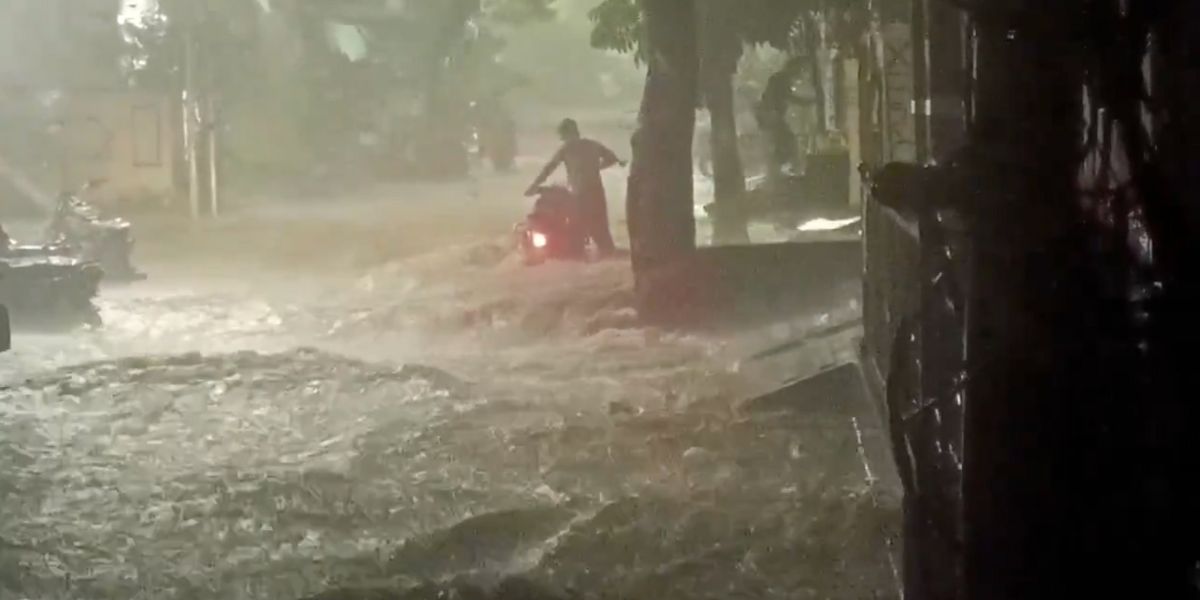This relentless and sharp rainfall exposed the cracks in infrastructure that go unnoticed during normal days, as officials tend to forget how severe rains can become.
Published Aug 10, 2025 | 11:02 AM ⚊ Updated Aug 10, 2025 | 11:02 AM

A waterlogged road in Hyderabad.
Synopsis: Ongoing heavy rainfall in Hyderabad is disrupting normal life amid the IMD’s warning of persistent rain. Vehicles remained stuck on the roads, moving painfully slowly, bumper to bumper, with water gushing onto the roads and swamping them.
The fragile rain infrastructure failed yet again on Saturday, 9 August, when the skies opened and sent sheets of rain across the wide expanse of Hyderabad, disrupting normal life.
The worst is yet to come. Residents should brace for more rain in the next few days. The India Meteorological Department (IMD) has predicted more rain over the next three days. The IMD forecasts a repeat of rain on Sunday evening, thunderstorms on Monday, and isolated thunderstorms on Tuesday. On all three days, afternoon thunderstorms are possible, which are more dangerous than normal rainfall.
The rains that lashed Hyderabad on Thursday, Friday, and Saturday brought misery in their wake due to severe flooding, inevitable traffic snarls, and pedestrians fearing for their lives, unsure of which manhole they might step into. Parts of the city remained under a blanket of darkness due to power failures.
Saturday’s cloudburst was the third in August and recorded a maximum of 12.5 cm in Charminar, followed by Begum Bazar (12.4 cm) and Khairatabad (11.9 cm). Other heavily affected zones were Himayatnagar (10.3 cm), Musheerabad (10.2 cm), and the Asifnagar reservoir (9.7 cm).
On Thursday evening, Gachibowli saw heavy rainfall of 12.35 cm. Saturday’s rainfall compounded this stress on city systems.
Though the rain on Friday was not heavy, it was enough to disrupt public life. The areas that experienced rainfall included Saroornagar (6.4 cm – highest) and Chandrayangutta (3.5 mm – lowest). The rain in Charminar and Nampally was light, while rain spared the western parts of the city, like Golkonda and Falaknuma.
The torrential rain brought the city to its knees. It wreaked havoc in areas like Malakpet, Tarnaka, Kondapur, and Gachibowli. Vehicles remained stuck on the roads, moving painfully slowly, bumper to bumper, with water gushing onto the roads and swamping them.
Hyderabad Disaster Management and Asset Protection Agency (HYDRAA) teams have been working across the city, draining floods using high-power pumps on Saturday night.
They were seen restoring a semblance of order to the chaos caused by the rains, particularly in areas like Goshamahal, Nampally, Ameerpet, Secunderabad, LB Nagar, Malakpet, and Musheerabad. They were seen removing garbage stuck in culverts and nalas.
At Krishna Nagar, the teams helped those stuck in the rain reach safety. They steered a private travel bus to elevated ground, as it was unable to navigate the swirling waters at the Metro Station at Mythrivanam.
As the disruption was immense and widespread, the teams, though they worked tirelessly all through the night, could not be of much help. Those stuck in traffic prayed for the mess to clear, which happened only late at night.
Those who thought they were lucky to remain indoors soon realised they were no better off. In Manikonda and other nearby residential areas, water quickly invaded homes. Residents struggled to drain water from their premises, hiring pumpsets. Exacerbating the traffic chaos, there were incidents of road cave-ins. For instance, in Banjara Hills, a water tanker got stuck in a drain that had collapsed.
This relentless and sharp rainfall, though heavy and lasting no more than one and a half hours, exposed the cracks in infrastructure that go unnoticed during normal days, as officials tend to forget how severe rains can become.
(Edited by Muhammed Fazil.)
